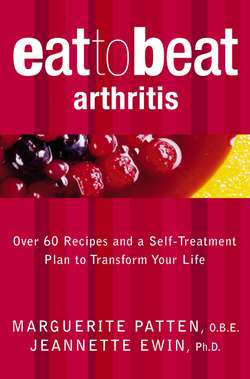Читать книгу Arthritis: Over 60 Recipes and a Self-Treatment Plan to Transform Your Life - Marguerite O.B.E. Patten - Страница 17
Chapter 2 Food, supplements and medication
Оглавление‘People are more easily convinced of the power of magic, than convinced of the healing power of nutrition.’
The above statement – one I often use to open seminars – is, sadly, very true. Yet you can halt the pain of arthritis by changing the way you eat. In most cases, the difference will be so great it will change your life forever. All that is required for this transformation is the knowledge of which foods to avoid and which to enjoy, and a commitment to staying on the diet long enough to experience its benefits. Once you have experienced the improvement it brings about you will be very reluctant to return to your old ways. The path to success is not easy, however. You will be giving up foods and drinks that are part of most people’s daily lives – for example, coffee, alcohol, bacon, bread and sugary sweets. These changes will be easier if you understand why they are necessary. Use this book as your guide, and you will soon find that you feel better, look better and no longer crave the foods that trigger the pain that once overshadowed your life.
Several years ago a group of women attending a community meeting about nutrition were asked for a show of hands as to how many agreed with the statement: eliminating a single food from the diet can change a person’s health. Less than a third agreed. During the discussion that followed, some people were slightly amused by the question: after all, they ate a ‘healthy’ diet, how could that do them harm? When asked to describe a ‘healthy diet’, it was generally agreed that a healthy diet consisted of foods they ‘had always eaten’. In fact, none of us eats ‘what we have always eaten’. Differences in food production and processing – along with changing cultural influences – have subtly reshaped both the content and nutritional value of the food we eat. A healthy diet entails eating a high proportion of fresh fruits and vegetables, pulses, grains and nuts, and a modest amount of meat.
Many consumers are confused by all the dietary advice provided in the media these days. What should we listen to: old advice that we have followed for years; or new opinions still untested by time? Listen to both, and then ask yourself which makes good sense. If promises made for a wonder food sound too good to be true, they probably are. If someone tells you that a special diet will help control an illness, ask why and how it works. That is why you should take time to read all the information in this book, rather than just trying the recipes. You need to become familiar with your enemy in order to beat it.
Do eggs dangerously increase levels of blood cholesterol? The answer to this question is an example of how conflicting information about the health value of a food arises. Until the medical community became convinced that high levels of blood cholesterol were a significant risk factor in coronary artery disease, eggs were looked upon as a safe and healthy food, ideal for all the family – including infants and the infirm. Then came the theory that the cholesterol contained in foods, such as egg yolk, increases the level of blood cholesterol. As a result, people were advised to reduce their intake of eggs to as few as two per week. Recently, scientific research has established that the cholesterol contained in eggs has very little effect on blood cholesterol: saturated fats, such as those found in red meat, are the culprits. Eggs contain a far lower percentage of saturated fat than a portion of cheese of equal weight and, when enjoyed in moderation, they are an easy-to-eat food, high in the protein and vitamins our bodies need. Produced by free-range hens fed on grain and free of infection, eggs are a welcomed part of breakfast, lunch or dinner. You will see in Parts Three and Four that eggs are very much a part of the Eat to Beat Arthritis Diet.
